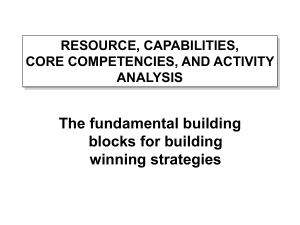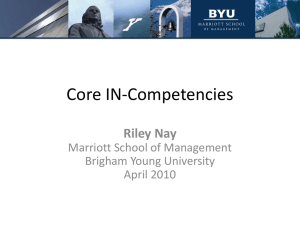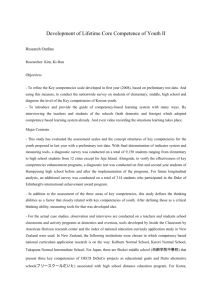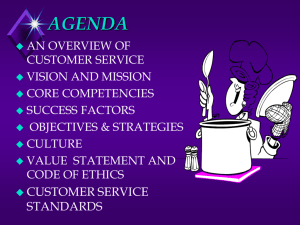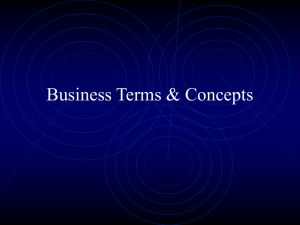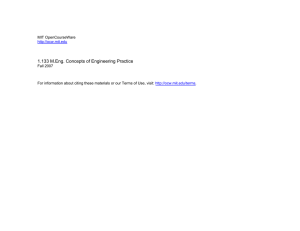RESOURCES AND CAPABILITIES
advertisement
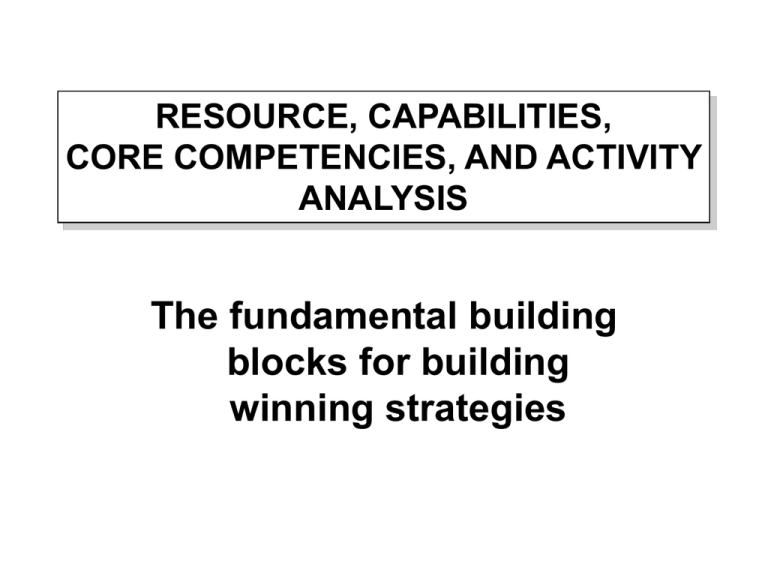
RESOURCE, CAPABILITIES, CORE COMPETENCIES, AND ACTIVITY ANALYSIS The fundamental building blocks for building winning strategies Key Elements of Business Strategies: Understanding Resources, Capabilities, and Competencies is the key Selecting a business strategy that exploits valuable resources and distinctive competencies (ie. competitive advantages) Ensuring that all resources and capabilities are fully employed and exploited Building and regenerating valuable resources and distinctive competencies -- competitive advantages Rationale for the Resource-based Approach to Strategy When the external environment is subject to rapid change, internal resources and capabilities offer a more secure basis for strategy than market focus Resources and capabilities are the primary source of profitability. Firm-specific strategic differences account for 50-70 percent of observed differences in firms’ profits Resources, Capabilities, and Competitive Advantage: The Basic Relationships COMPETITIVE ADVANTAGE STRATEGY INDUSTRY KEY SUCCESS FACTORS ORGANIZATIONAL CAPABILITIES RESOURCES Tangible Intangible Human Categories of Firm Resources • Financial • Physical • Human • Technological • Reputational $ ¥ £ Valuable Resources and Competencies: The “key” to Competitive Advantages Resources can be: – Physical ie the wiring into your home (ramp for the info highway) – Human ie. skilled and creative employees (Wal*Marts’ dedicated employees) – Intangible ie. brand names and technological know-how (Coca-Cola, Disney, Sharp LCDs) – Organizational Capabilities embedded in the business’ routines, processes, culture (Japanese auto makers) Defining Organizational Capabilities Organizational Capabilities = firm’s capacity for undertaking a particular activity. (Grant) Distinctive Competence = things that an organization does particularly well relative to competitors. (Selznick) Core Competence = capabilities that are fundamental to a firm’s strategy and performance. (Hamel and Prahalad) What Makes a Resource Valuable? Scarcity Appropriability Demand Value creation zone The dynamic interplay of three fundamental market forces determines the value of a resource. Source: Collis and Montgomery, Corporate Strategy (1996) Resource Imitability Cannot be imitated: Patents Unique location Unique assets (e.g. Mineral rights) Difficult to Imitate: Brand Loyalty Favorable cost position Employee Satisfaction Reputation for Fairness Can be Imitated (but may not be): Capacity Pre-emption Economies of Scale Easy to Imitate: Cash Commodities Source: Collis and Montgomery, Corporate Strategy: Resources and the Scope of the Firm (1996). First-Mover Advantages in Resource Acquisition Patents Brand Recognition Reputation Accumulated Learning Attractive Locations Installed Base Identifying a Company’s Identifying a Company's Capabilities Capabilities and Value Chain Functional Area Capability Example • Corporate head office • Management information • Research and development • Manufacturing • Product design • Marketing • Capability in basic research • Ability to produce innovative products e.g., IBM, AT&T, Sony • 3M • Canon • Speed of new product development • Sales and distribution Source: Robert M. Grant, Contemporary Strategy Analysis, Basil Blackwell, 1991. Summary: Key Elements of Resource-Based Strategy Select a strategy that exploits principal resources and competencies. Ensure that resources are fully employed and exploited. Build a resource base. Source : Hamel and Prahalad Strategic Implications of Competing on Resources Investing in resources, continually Upgrading resources, creating or acquiring new resources, finding alternatives resources Leveraging resources Rapid redeployment of resources
